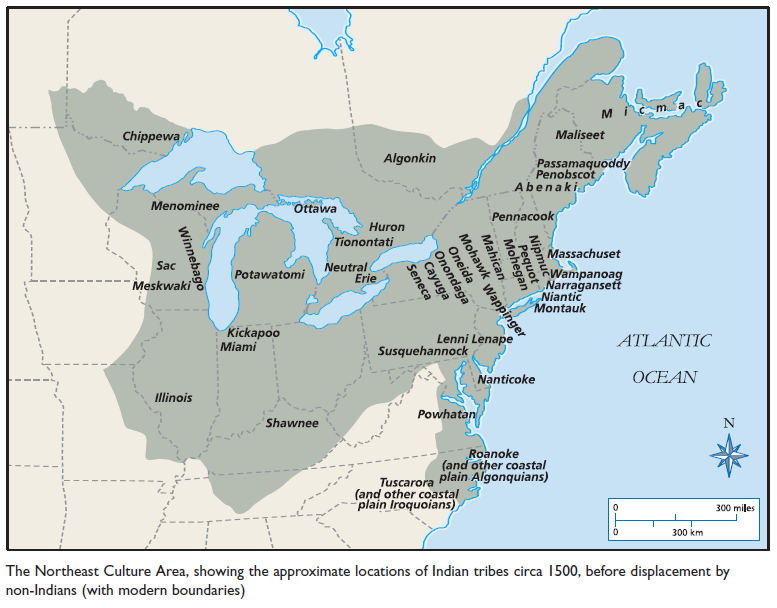
The Northeast Culture Area encompasses the region from the Atlantic Ocean to the Mississippi River, and from the Great Lakes to the Ohio Valley, including the Chesapeake Bay and Tidewater area. This area includes present-day states such as Maine, Vermont, New Hampshire, Massachusetts, Rhode Island, Connecticut, New York, New Jersey, Pennsylvania, Delaware, Ohio, Indiana, Illinois, and Michigan. It also covers most of Maryland, West Virginia, Kentucky, and Wisconsin, and smaller parts of Virginia, North Carolina, Missouri, Iowa, and Minnesota. The Canadian provinces of Nova Scotia, New Brunswick, and Prince Edward Island, as well as parts of Quebec and Ontario and a tiny piece of Manitoba, are also included.
The Northeast Culture Area is primarily covered by woodlands, leading to its nickname as the Northeast Woodland culture area. The region is diverse in terms of terrain, including sea coasts, hills, mountains, lakes, and river valleys, with the Appalachian Mountains running through the area. The five Great Lakes are located in the north-central region, while major rivers such as the St. Lawrence, Ottawa, Connecticut, Hudson, Delaware, Susquehanna, Allegheny, Ohio, Wabash, and Illinois flow through the area.
The forests of the Northeast were an essential resource for the indigenous peoples, providing wood for houses, boats, tools, and fuel, as well as bark for clothing, roofing, and bedding. The region was also home to abundant game, including deer, which was a vital resource for Native Americans. The oceans, lakes, and rivers were a plentiful source of fish and shellfish.
In addition to hunting and gathering, Northeast Indians were also farmers. They had permanent villages with cultivated fields, but generally left these villages during certain seasons to hunt and live on the trail. Many tribes can thus be considered "seminomadic."
The Northeast Indians spoke dialects of two language families: Algonquian, part of the Macro-Algonquian language phylum, and Iroquoian, part of the Macro-Siouan language phylum. Although these groups shared many cultural traits, there were also differences, such as the type of dwelling preferred. Algonquian peoples typically lived in wigwams, while most Iroquoian peoples lived in longhouses.
The various Northeast Algonquians included here are listed under the entry ALGONQUIANS. The
different Northeast Iroquoians included are the IROQUOIS
(HAUDENOSAUNEE)—that is, the CAYUGA,
MOHAWK, ONEIDA, ONONDAGA, SENECA, and TUSCARORA—
as well as the ERIE, HURON (WYANDOT),
NEUTRAL, SUSQUEHANNOCK, and TIONONTATI. Only
one tribe of the Northeast Culture Area spoke a language
other than Algonquian or Iroquoian: the WINNEBAGO
(HO-CHUNK), who spoke a dialect of the
Siouan language family.